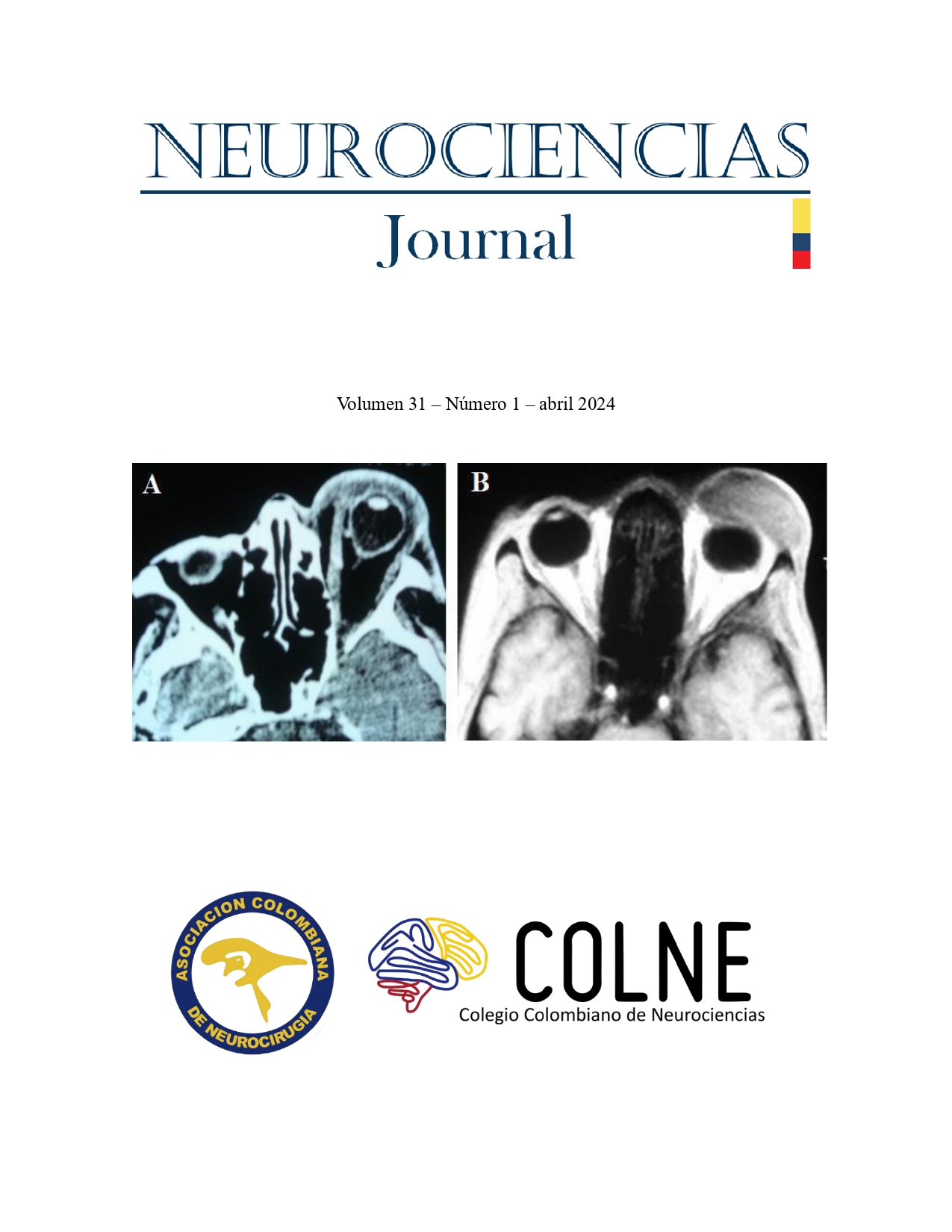Evaluation of Ocular Signs in the Comatose Patient: A review of the literature
DOI:
https://doi.org/10.51437/nj.v31i1.457Palabras clave:
Ocular motility disorders, Pupil disorders, Coma, Disorders of consciousnessResumen
Introduction: The Ascending Reticular Activating System (ARAS) is responsible for maintaining consciousness. This network traverses the brainstem and has multiple projections to the cerebral cortex. The ARAS is anatomically related to the oculomotor and optic nuclei; therefore, when affected, certain ocular signs should be evaluated. During the neuro-ophthalmological assessment of a patient with a consciousness disorder, pupils, eye movements, and oculocephalic reflexes should be explored to locate the lesion and its etiology (toxic, metabolic, or traumatic). This manuscript aims to review the most notable characteristics of evaluating ocular signs in comatose patients.
Methods: This work consists of a review of scientific literature related to the evaluation of ocular signs in comatose patients. An exhaustive search was conducted on PubMed, Scopus, and Web of Science. Studies providing relevant information on the evaluation of ocular signs in patients with consciousness disorders were selected.
Results: Several ocular signs were identified that may indicate involvement of the ARAS, such as changes in pupil size and reactivity, restrictions in eye movements, and abnormal responses to oculocephalic reflexes. These findings can assist physicians in locating the underlying lesion and determining its etiology, thereby facilitating appropriate clinical management.
Conclusions: The assessment of ocular signs in comatose patients is a valuable tool in clinical practice. Early recognition of these signs can enable swift and accurate interventions to treat life-threatening injuries. Further studies are needed to validate the efficacy and accuracy of these signs in the diagnosis and management of consciousness disorders.
Citas
References:
Posner JB., Saper CB., Schiff N., Plum F. Plum and Posner’s diagnosis of stupor and coma. vol. 71. vol. 71. 4.a edición. Oxford University Press; 2007.
Liu GT., Galetta SL. The neuro-ophthalmologic examination (including coma). Ophthalmol Clin North Am. 2001;14(1):23-39, vii.
Handbook of Clinical Neurology 3RD Series. Handb Clin Neurol. 2012;108(C):v, doi: 10.1016/B978-0-444-52899-5.00005-8.
Somlai J. Neuro-Ophthalmology. 2016.
Suarez JI. Critical Care Neurology and Neurosurgery. Humana Press; 2004.
Rodríguez Barrios R., Bottinelli MD., Medoc J. The study of ocular motility in the comatose patient. J Neurol Sci. s. f.;3(2):183-206.
Rosenberg ML. The eyes in hysterical states of unconsciousness. J Clin Neuroophthalmol. 1982;2(4):259-60.
Henry JA., Woodruff GH. A diagnostic sign in states of apparent unconsciousness. Lancet (London, England). 1978;2(8096):920-1.
Rosenberg ML. Spontaneous vertical eye movements in coma. Ann Neurol. 1986;20(5):635-7, doi: 10.1002/ana.410200514.
Rosa., JR R. 2015-2016 Basic and Clinical Science Course (bcsc): Ophthalmic Pathology and Intraocular Tumors. Section 4. 2015.
Hudson AJ. Consciousness: physiological dependence on rapid memory access. Front Biosci (Landmark Ed. 2009;14:2779-800.
von Cramon D. Consciousness and disturbances of consciousness. J Neurol. 1978;219(1):1-13.
Edlow BL., Takahashi E., Wu O., Benner T., Dai G., Bu L., et al. Neuroanatomic connectivity of the human ascending arousal system critical to consciousness and its disorders. J Neuropathol Exp Neurol. 2012;71(6):531-46, doi: 10.1097/NEN.0b013e3182588293.
Moruzzi G., Magoun HW. Brain stem reticular formation and activation of the EEG. Electroencephalogr Clin Neurophysiol. 1949;1(4):455-73.
Yeo SS., Chang PH., Jang SH. The ascending reticular activating system from pontine reticular formation to the thalamus in the human brain. Front Hum Neurosci. 2013;7:416, doi: 10.3389/fnhum.2013.00416.
Hess CW., Bassetti C. [Neurology of consciousness and of consciousness disorders]. Schweiz Rundsch Med Prax. 1994;83(8):212-9.
Berson DM. Strange vision: ganglion cells as circadian photoreceptors. Trends Neurosci. 2003;26(6):314-20, doi: 10.1016/S0166-2236(03)00130-9.
Dacey DM., Liao H-W., Peterson BB., Robinson FR., Smith VC., Pokorny J., et al. Melanopsin-expressing ganglion cells in primate retina signal colour and irradiance and project to the LGN. Nature. 2005;433(7027):749-54, doi: 10.1038/nature03387.
McDougal DH., Gamlin PD. Autonomic Control of the Eye. Comprehensive Physiology, vol. 5. Hoboken, NJ, USA: John Wiley & Sons, Inc.; 2014. p. 439-73.
Gooley JJ., Ho Mien I., St Hilaire MA., Yeo S-C., Chua EC-P., van Reen E., et al. Melanopsin and rod-cone photoreceptors play different roles in mediating pupillary light responses during exposure to continuous light in humans. J Neurosci. 2012;32(41):14242-53, doi: 10.1523/JNEUROSCI.1321-12.2012.
Riordan-Eva P. Neuro-Ophthalmology. En: Riordan-Eva P, Augsburger JJ, eds. Vaughan & Asbury’s General Ophthalmology, 19e. New York, NY: McGraw-Hill Education; 2017.
Ropper AH., Samuels MA., Klein JP. Chapter 14. Disorders of Ocular Movement and Pupillary Function. Adams and Victor’s Principles of Neurology, 10e. New York, NY: The McGraw-Hill Companies; 2014.
Wilhelm H. Disorders of the pupil. Handbook of clinical neurology, vol. 102. 2011. p. 427-66.
Wehrwein EA., Orer HS., Barman SM. Overview of the Anatomy, Physiology, and Pharmacology of the Autonomic Nervous System. Compr Physiol. 2016;6(3):1239-78, doi: 10.1002/cphy.c150037.
Park HK., Rha HK., Lee KJ., Chough CK., Joo W. Microsurgical Anatomy of the Oculomotor Nerve. Clin Anat. 2017;30(1):21-31, doi: 10.1002/ca.22811.
Walton KA., Buono LM. Horner syndrome. Curr Opin Ophthalmol. 2003;14(6):357-63.
Cianfoni A., Pravatà E., De Blasi R., Tschuor CS., Bonaldi G. Clinical presentation of cerebral aneurysms. Eur J Radiol. 2013;82(10):1618-22, doi: 10.1016/j.ejrad.2012.11.019.
Simon RP., Aminoff MJ., Greenberg DA. Coma. Clinical Neurology, 10e. New York, NY: McGraw-Hill Education; 2017.
Tokuda Y., Nakazato N., Stein GH. Pupillary evaluation for differential diagnosis of coma. Postgrad Med J. 2003;79(927):49-51.
Suys T., Bouzat P., Marques-Vidal P., Sala N., Payen J-F., Rossetti AO., et al. Automated Quantitative Pupillometry for the Prognostication of Coma After Cardiac Arrest. Neurocrit Care. 2014;21(2):300-8, doi: 10.1007/s12028-014-9981-z.
Greer DM., Yang J., Scripko PD., Sims JR., Cash S., Kilbride R., et al. Clinical examination for outcome prediction in nontraumatic coma*. Crit Care Med. 2012;40(4):1150-6, doi: 10.1097/CCM.0b013e318237bafb.
Huff JS., Austin EW. Neuro-Ophthalmology in Emergency Medicine. Emerg Med Clin North Am. 2016;34(4):967-86, doi: 10.1016/j.emc.2016.06.016.
Simon RP., Aminoff MJ., Greenberg DA. Neuro-Ophthalmic Disorders. Clinical Neurology, 10e. New York, NY: McGraw-Hill Education; 2017.
Pullen RL. Checking for oculocephalic reflex. Nursing (Lond). 2005;35(6):24.
van den Berge JH., Schouten HJ., Boomstra S., van Drunen Littel S., Braakman R. Interobserver agreement in assessment of ocular signs in coma. J Neurol Neurosurg Psychiatry. 1979;42(12):1163-8, doi: 10.1136/JNNP.42.12.1163.


